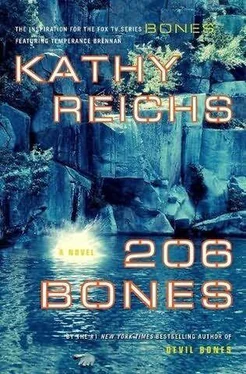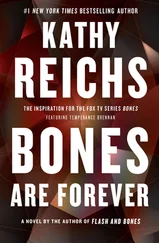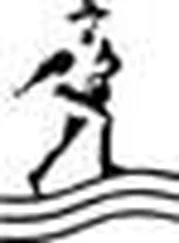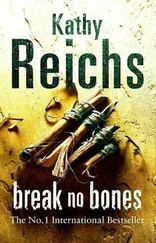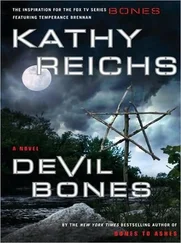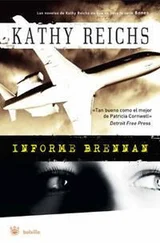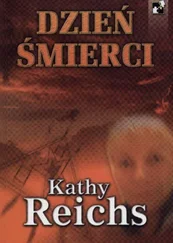KATHY REICHS - 206 BONES
Здесь есть возможность читать онлайн «KATHY REICHS - 206 BONES» весь текст электронной книги совершенно бесплатно (целиком полную версию без сокращений). В некоторых случаях можно слушать аудио, скачать через торрент в формате fb2 и присутствует краткое содержание. Жанр: Триллер, на английском языке. Описание произведения, (предисловие) а так же отзывы посетителей доступны на портале библиотеки ЛибКат.
- Название:206 BONES
- Автор:
- Жанр:
- Год:неизвестен
- ISBN:нет данных
- Рейтинг книги:3 / 5. Голосов: 1
-
Избранное:Добавить в избранное
- Отзывы:
-
Ваша оценка:
- 60
- 1
- 2
- 3
- 4
- 5
206 BONES: краткое содержание, описание и аннотация
Предлагаем к чтению аннотацию, описание, краткое содержание или предисловие (зависит от того, что написал сам автор книги «206 BONES»). Если вы не нашли необходимую информацию о книге — напишите в комментариях, мы постараемся отыскать её.
206 BONES — читать онлайн бесплатно полную книгу (весь текст) целиком
Ниже представлен текст книги, разбитый по страницам. Система сохранения места последней прочитанной страницы, позволяет с удобством читать онлайн бесплатно книгу «206 BONES», без необходимости каждый раз заново искать на чём Вы остановились. Поставьте закладку, и сможете в любой момент перейти на страницу, на которой закончили чтение.
Интервал:
Закладка:
“How is this germane?” Clearly, Schechter liked the word.
“It is germane to your client’s understanding of what happened to his daughter. And, perhaps more important, what did not.”
Again the hand.
“I will not belabor the importance of distinguishing between perimortem and postmortem trauma. I would like to make clear, however, that, for the anthropologist, this distinction has more to do with bone quality than it does with time of death. It’s a complex subject, so forgive me if I oversimplify.
“In fresh or living bone the moisture content is relatively high and the collagen, the component that gives bone its elasticity, is somewhat flexible. This permits a certain degree of bending under stress. With decomposition, moisture is lost and collagen degrades, so the bending capability diminishes. In other words, dry bone responds to loading like an inorganic, rather than an organic, material. It fails, or breaks, when subjected to smaller forces. Think of a green stick versus a dry stick. The former yields, the latter snaps under pressure.”
Schechter made a note on his tablet but did not interrupt.
“Practically speaking, this means that fractures to dry bone are less clean and have more jagged edges. Fragments tend to be smaller. Breakaway spurs, relatively common in fresh bone, are rare. Concentric circular and radiating fractures, patterns produced by the transmission of energy through bone, are uncommon.”
“Most impressive. We’re all experts now.”
Knowing his game book, I ignored Schechter’s rudeness.
“Distinguishing an antemortem injury or defect is equally important in accurately determining manner of death. Since the first signs of healing are often difficult to detect, skeletal remains are examined on three levels, macroscopic, radiographic, and histologic.”
“Let’s skip the jargon.” Schechter.
“Macroscopic means eyeballing. The first indication of antemortem repair is a narrow band of surface resorption immediately adjacent to the fracture site. This reflects inflammation at the point where the overlying membrane was torn away. Next, gradual erosion can be seen at the broken ends. These changes are evident anywhere from ten to fourteen days after injury.
“Radiographic means X-ray. Here healing appears as a blurring of the fractured edges, again roughly ten to fourteen days post-injury. The gap between the broken ends then widens as callus formation proceeds.”
Schechter’s eyes narrowed slightly.
“A callus is an unorganized network of woven bone that forms quickly at a fracture site. It functions like putty to hold the broken ends in place. As repair progresses, the callus is gradually replaced by true bone.
“Histologic means under the microscope. Here healing is first evidenced by spicules of woven bone within the callus. These spicules can be seen as early as five to seven days post-injury.”
“Will we be getting to Rose sometime today?”
I opened a new PowerPoint file. Rose’s skeleton was now in my lab, clean of soil and tissue. Each bone was aligned with anatomical precision, right down to the distal phalanges of the hands and feet.
“As Detective Ryan mentioned earlier, the remains suffered considerable postmortem damage due to animal scavenging.”
I chose a shot of Rose’s right thigh bone. Instead of a rounded knob on one end and condyles on the other, the femoral shaft terminated in long jagged spikes. I clicked to the tibia, then the fibula, demonstrating similar damage in the lower leg.
“Notice the cracking and longitudinal splintering. Those features, along with dispersal of elements away from the body, suggest large carnivore feeding.”
Moving to a femoral close-up, I pointed the laser at one circular defect, then another.
“Those are canine tooth punctures. Based on size, I’d say the diners were Ursus americanus. ”
“Black bears,” Corcoran said.
“Bears eat carrion?” Schechter made no attempt to hide his revulsion.
“With relish,” I said.
I proceeded to a tight shot of the lower jaw.
“But they weren’t alone. Notice the lower edge.” I ran the beam along the mandibular border. “See the parallel grooving?”
“Rodent gnawing,” Corcoran said.
“Exactly. Once skeletonization was complete, the rats and mice moved in.”
Corcoran was slowly wagging his head. “I’ve never understood the appeal once the flesh is gone.”
“Dry bone is a rich source of dietary mineral and protein.”
Schechter pulled on his nose with a thumb and index finger. “If your point is to shock me, Dr. Brennan, you fail.”
“My point is to inform you.”
“Let’s cut to the chase.” Schechter glared in my direction.
“Let’s.” I almost smiled. I was looking forward to deflating this arrogant gasbag.
“Bottom line.” Leaning forward, I rested my forearms and interlaced my fingers as Schechter had done. “I observed significant damage to Rose Jurmain’s skeleton, all of it postmortem in nature.”
“What do you mean postmortem in nature?”
“I mean postmortem. As in, inflicted after death.”
“By bears.”
“And rodents.”
“You observed no evidence of perimortem trauma?”
“Neither perimortem nor antemortem.”
“What about the sternum.”
“You heard me.”
Schechter’s mouth crawled into a reptilian smile. “Have you no image of the sternum, Doctor ? Or are you reluctant to share it?”
Ryan moved forward in his chair. I laid a hand on his arm. He looked at me. I gave a barely perceptible shake of my head.
“ C’est un ostie de crosseur. ” The guy’s a flaming asshole. Roughly translated.
“He’s going down,” I replied in French.
I worked keys on my laptop. Rose’s breastbone replaced her jaw on the screen. Beside it was an X-ray.
Snatching the pointer, Schechter danced the red dot around a small round defect two inches up from the bone’s lower end. The dot then shot to the X-ray, where the defect appeared as a dark circle within the gray-white of the bone’s spongy interior.
“You going to tell me bears did that?”
“No. I am not.”
“How do you explain it?” Schechter demanded.
“How do you explain it?” I asked, almost sweetly.
“Clearly that’s a gunshot wound.”
“I see no evidence of that.”
“Meaning?”
“No bullet fragments or metallic trace on the X-ray. No jagged edges. No shattered bits of bone. No radiating fractures or blowout fragments.”
“You’re saying the hole is antemortem trauma?”
“No. I am not.” I knew it was childish to bait Schechter but couldn’t help myself. The guy was so unpleasant I was looking forward to booting him under the bus.
“Explain.”
“The hole did not result from trauma of any kind.”
“Not trauma.” For the first time Schechter’s voice held a note of uncertainty.
“No.”
“Elaborate.”
“My explanation requires an understanding of sternal development.”
Schechter did the hand thing. With a bit less flair than before.
I gathered my thoughts, then began.
“The sternum begins life as two vertical cartilaginous bars lying one beside the other. Eventually, the bars fuse along the midline. The cartilaginous sternum then ossifies, meaning it turns to bone. This ossification progresses from six centers, four of which form the body, or long thin part, of the sternum. If there’s no objection I’ll confine my comments to the sternal body, since that’s where the hole is situated.”
“Please.” It was Schechter’s first use of the word all morning.
I moved the laser sideways across Rose’s sternum.
Читать дальшеИнтервал:
Закладка:
Похожие книги на «206 BONES»
Представляем Вашему вниманию похожие книги на «206 BONES» списком для выбора. Мы отобрали схожую по названию и смыслу литературу в надежде предоставить читателям больше вариантов отыскать новые, интересные, ещё непрочитанные произведения.
Обсуждение, отзывы о книге «206 BONES» и просто собственные мнения читателей. Оставьте ваши комментарии, напишите, что Вы думаете о произведении, его смысле или главных героях. Укажите что конкретно понравилось, а что нет, и почему Вы так считаете.
